NASA announced on Thursday that the James Webb Space Telescope has found a beautifully bright star system that existed just 290 million years after the Big Bang, potentially setting a new record for the most distant known galaxy.
The Webb telescope, which went online in 2022 and is now looking back in time as well as farther than ever before into the darkest reaches of the universe, has ushered in a new era of scientific discoveries.
Furthermore, experts stated that the most recent discovery has “profound implications” for the understanding of the original Cosmic Dawn.
The galaxy known as JADES-GS-z14-0 was first observed by an international group of astronomers in early 2023, but they stated in a joint statement that more observations were need to confirm that the galaxy was, in fact, a record-breaker rather than a “confounding oddball.”
Stefano Carniani from Scuola Normale Superiore in Italy and Kevin Hainline from the University of Arizona stated, “The source was surprisingly bright, which we wouldn’t expect for such a distant galaxy, and it was very close to another galaxy such that the two appeared to be part of one larger object.”
The universe is growing, extending light from the farthest galaxies until it reaches Earth. This changes the light into the infrared spectrum, which Webb can detect with previously unseen clarity.
To be more convinced of their principle, the researchers conducted two follow-up observations in October and January: the first using Webb’s primary imager, dubbed NIRCam, and the second using its NIRSpec, which examines an object’s light to establish its physical characteristics.
In addition to easily surpassing the previous record for the oldest known galaxy, held by JADES-GS-z13-0, which existed 320 million years after the Big Bang, the new discovery also poses fascinating new scientific problems.
Upends expectations:
“The most important aspect of JADES-GS-z14-0 was that at this distance, we know that this galaxy must be intrinsically very luminous,” according to Carniani and Hainline.
The galaxy’s estimated size from the photos is 1,600 light years, indicating that the light is primarily coming from young stars rather than emission from a supermassive black hole that is getting closer to Earth.
“This starlight implies that the galaxy is several hundreds of millions of times the mass of the Sun!” stated the investigators. “This raises the question: How can nature make such a bright, massive, and large galaxy in less than 300 million years?”
Oxygen has been found through additional examination of the light emissions, which is another unexpected discovery that suggests “multiple generations of very massive stars had already lived their lives before we observed the galaxy.”
When together, the JADES-GS-z14-0 observations challenge astronomical hypotheses about the possible makeup of the first galaxies that emerged 13.8 billion years after the Big Bang.
The researchers stated it’s very probable other brilliant galaxies at maybe even earlier times would be uncovered in the coming years given the very small section of the night sky they looked at. They will now attempt to publish their findings in a peer-reviewed publication.












